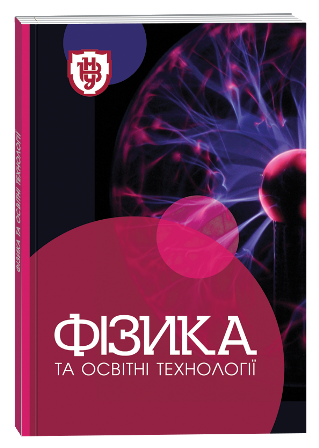LUMINESCENT PROPERTIES OF RARE-EARTH METALS IN GLASS ENVIRONMENTS
DOI:
https://doi.org/10.32782/pet-2022-1-14Keywords:
luminescence, radiation mechanism, rare earth metals, relaxation of ions, chalcogenide matrixAbstract
The article analyzes the features of radiation of the rare earth metals (REM) under influence of exciting factors. The theory of radiative and non-radiative relaxation in the 4f-shell of REM ions was applied to establish the radiation mechanism. The main processes that take place in luminescent centers are considered. Factors affecting the luminescent properties of some chalcogenide matrices doped REM ions were studied and systematized. The nature of radiation photons, which depends on the initial and final state and on the excitation mechanism, is analyzed. It was found that in order to obtain intense radiation, in a given spectral range, it is necessary to establish the energy position of the ground and excited states of activating impurities, as well as the mechanism of radiative relaxation, as a result of which the system transitions to a metastable or ground state. Experimental data from literary sources indicate a significant influence of defects, impurities, inhomogeneities and the local environment near rare earth ions in the glass-forming matrix on the processes of light emission in glass media. It was established that the longer relaxation time is the result of a decrease in the probability of nonradiative relaxation due to the large energy distance between excited states and the low energy of phonons of the glassy matrix. A decrease in the relaxation time can also occur as a result of the energy transfer between the REM ions. The analysis of research shows that in order to establish the mechanism of photoluminescence (PL) in various matrices and to increase its efficiency, it is necessary to combine the models of radiation of REM ions with experimental results. The interpretation of experimental data on photoluminescence and optical absorption spectra is based on a detailed study of the mechanisms radiative transitions in various chalcogenide matrices.
References
Halyan V.V., Kevshin A.H., Davydyuk G.Ye., Shevchuk N.V. Mechanism of anti-stokes photoluminescence in Ag0.05Ga0.05Ge0.95S2–Er2S3 glassy alloys. Glass Phys. Chem. 2013. Vol. 39. P. 52–56.
Halyan V.V., Ivashchenko I.A., Kevshyn A.H., Olekseyuk I.D., Tishchenko P.V., Tretyak A.P. Growth of the (Ga69.5La29.5Er)2S300 Single Crystal and Mechanism of Stokes Emission / J. Nano- Electron. Phys. 2019. Vol. 11. P. 01008-1–01008-4.
Асабина Е.А. Дефекты в твердых телах и их влияние на свойства функциональных материалов. Нижний-Новгород : НГУ, 2012. C. 65.
Lupan E. Emission spectra of Ge25Ga1.7As8.3S65 glass doped with Sm3+ and Nd3+. J Non-Oxide Glass. 2009. V. 1, No. 3. P. 183–189.
Tver’yanovich Yu.S., Degtyarev S.V., Pivovarov S.S. [and others].The environment of Nd3+, Sm3+, Yb3+ in chalcogenide glasses containing gallium and germanium / J. Non Cryst. Solids. 1999. Vol. 256-257. P. 95–99.
Zh. Xu, Kang X., Ch. Li [and others] Ln3+ (Ln= Eu, Dy, Sm, and Er) ion-doped YVO4 nano/microcrystals with multiform morphologies: Hydrothermal synthesis, growing mechanism, and luminescent properties. Inorg. Chem. 2010. Vol. 49. № 14. P. 6706–6715.
Shen X., Nie Q., Xu T., Dai Sh., Wang X. Temperature dependence of upconversion luminescence in erbium-doped tellurite glasses. J Lumin. 2010. Vol. 130. P. 1353–1356.
Wang N. Q., Zhao X., Li C.M. [and others]. Upconversion and color tunability in Tm3+/Ho3+/Yb3+ doped low phonon energy bismuth tellurite glasses. J. Lumin. 2010. Vol. 130. P. 1044–1047.
Курков А.С., Дианов Е.М. Непрерывые волоконные лазеры средней мощности. Квантовая электроника. 2004. Т. 34. № 10. С. 881–900.
Halyan V.V., Kityk I.V., Kevshyn A.H., Ivashchenko I.A., Lakshminarayana G., Shevchuk M.V., Fedorchuk A., Piasecki M. Effect of temperature on the structure and luminescence properties of Ag0.05Ga0.05Ge0.95S2–Er2S3 glasses / J. Lumin. 2017. Vol. 181. P. 315–320.
Kityk I.V., Halyan V.V., Yukhymchuk V.O., Strelchuk V.V., Ivashchenko I.A., Zhydachevskii Ya., Suchocki A., Olekseyuk I.D., Kevshyn A.G., Piasecki M. NIR and visible luminescence features of erbium doped Ga2S3–La2S3 glasses. J Non Cryst Solids. 2018. Vol. 498. P. 380–385.
Halyan V.V., Yukhymchuk V.O., Ivashchenko I.A., Kozak V.S., Tyshchenko P.V., Olekseyuk I.D. Synthesis and downconversion photoluminescence of Erbium-doped chalcohalide glasses of AgCl(I)–Ga2S3–La2S3 systems. Applied Optics. 2021. V. 60. P. 5285–5290.
Lozano W., Ara C. B., Ledemi Y., Messaddeq Y. Upconversion luminescence in Er3+ doped Ga10Ge25S65 glass and glass-ceramic excited in the near-infrared /. J. Appl. Phys. 2013. Vol. 113. P. 083520-1–083520-6.
Messaddeq S.H., Siu Li M., Lezal D., Raman investigation of structural photoinduced irreversible changes of Ga10Ge25S65 chalcogenide glasses / [and others]. J. Optoelectronics & Adv. Mater. 2001. Vol. 3. P. 295–302.
Halyan V.V., Strelchuk V.V., Yukhymchuk V.O. [and others]. Role of structural ordering on optical properties of the glasses Ag0,05Ga0,05Ge0,95S2–Er2S3. Physica B Condens. Matter. 2013. Vol. 411, № 15. P. 35–39.
Frej M.L., Valdez E., de Araújo C.B. [and others]. Stokes and anti-Stokes luminescence of Er3+ doped Ga10Ge25S65 glass excited at 980 and 532 nm. J. Appl. Phys. 2010. Vol. 108. P. 093514-1–093514-5.
Ge Li, Li Lini, Xinyu Huang [and others]. Er3+ doped and Er3+/Pr3+ co-doped gallium-antimony-sulphur chalcogenide glasses for infrared applications. Opt. Mater. Express. 2016. Vol. 6. P. 3849–3856.
J. Heo, W. Y. Cho, W. J. Chung. Sensitizing effect of Tm3+ on 2.9 μm emission from Dy3+-doped Ge25Ga5S70 glass / J. Non Cryst. Solids. 1997. Vol. 212(s2–3). P. 151–156.
Tian Y., Xu R., Hu L., Zhang J. 2.7 μm fluorescence radiative dynamics and energy transfer between Er3+ and Tm3+ions in fluoride glass under 800 nm and 980 nm excitation. J Quant Spectrosc Radiat Transf. 2012. Vol. 113. P. 87–95.
Golding P. S., Jackson S. D., King T. A., Pollnau M. Energy transfer processes in Er3+-doped and Er3+, Pr3+-codoped ZBLAN glasses. Phys. Rev. B. 2000. Vol. 62. P. 856–864.








